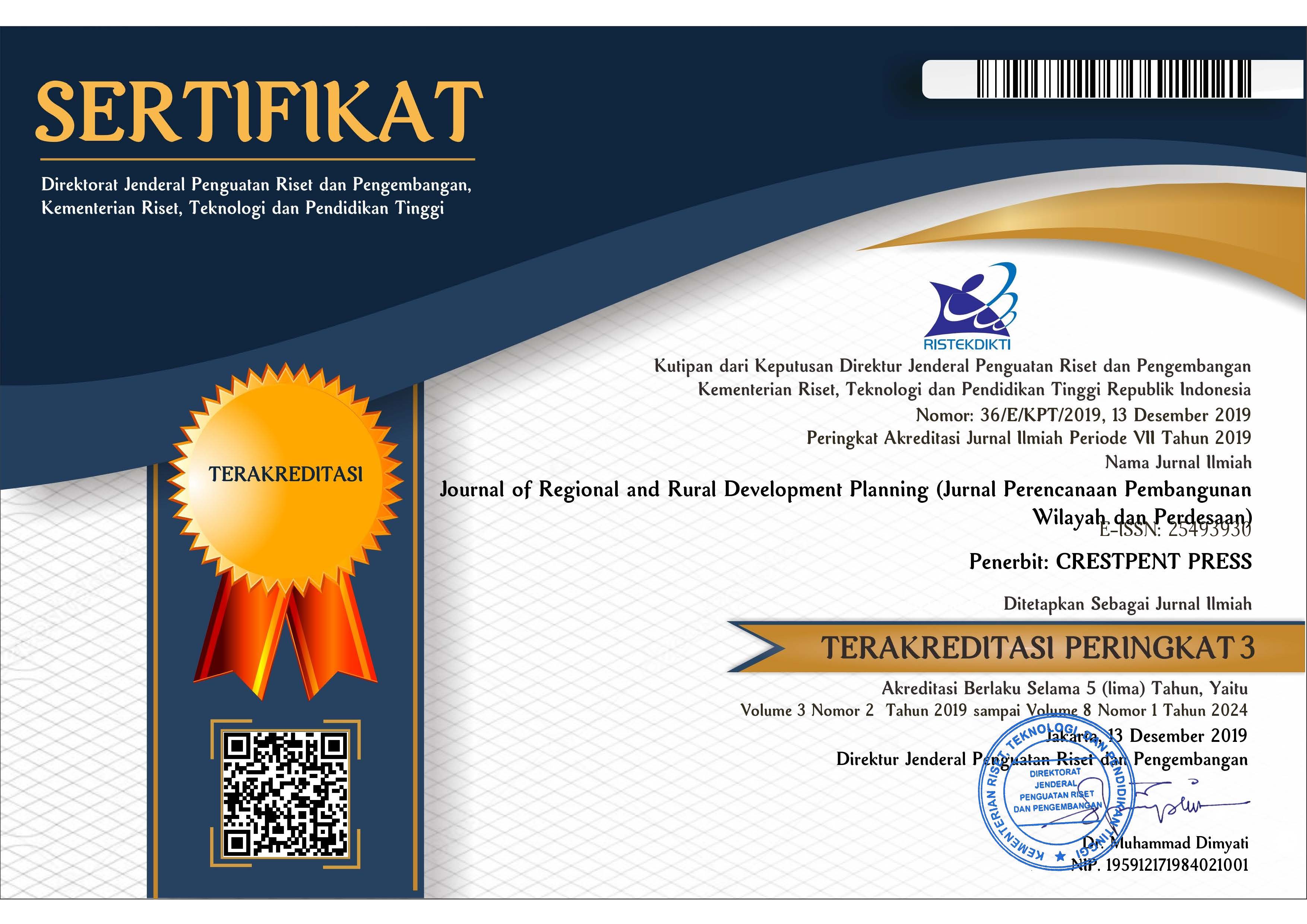Pola Interaksi Spasial serta Karakteristik Individu dan Rumah Tangga Komuter antar Kabupaten/Kota di Bandung Raya
DOI:
https://doi.org/10.29244/jp2wd.2020.4.2.113-133Keywords:
commuter, correspondence analysis, entropy, spatial interactionAbstract
Spatial Interaction Pattern and Characteristics of Individual and Household Commuters between Regencies/Cities in Greater Bandung
Differences in regional development in Greater Bandung caused spatial interaction in order to meet the shortcomings in origin areas. One of the form spatial interaction is commuting. This study aimed to analyze the pattern of spatial interaction between regencies/cities in Greater Bandung and determine individual and household commuter characteristics. Variables used to analyze the pattern of spatial interactions were number of commuters, distances, regional development index, built up area ratio, and population density of regency/city units in Greater Bandung. Method used were Entropy Index and Augmented Doubly Constrained Entropy Model. Variables used to determine individual and household commuter characteristics were age, marital status, highest education completed, number of household members, monthly household expenditure, and the main reason for choosing settlement location. Data were originated from 2017 Greater Bandung Commuter Survey held by Statistics Indonesia (BPS), which consists of 15,082 individuals and 4,531 households. The method used was correspondence analysis. Analysis results shows that Bandung Regency, Sumedang Regency, and Bandung City had positive effects on spatial interactions in Greater Bandung. Commuters in Greater Bandung mostly come from regency areas with productive age, low education level, big number of household members, have low and high economic level, live in regency area because of affordable house price and closeness to family. Meanwhile, commuters in Greater Bandung mostly move toward city areas have young and productive age, high education level, have low and high economic level, and variety number of household members.
References
Bengi, A. S., & Jamal, A. (2017). Faktor-faktor yang mendorong tenaga kerja melaju dari Kabupaten Aceh Besar ke Kota Banda Aceh. Jurnal Ilmiah Mahasiswa (JIM) Ekonomi Pembangunan Fakultas Ekonomi dan Bisnis Unsyiah, 2 (3), 396–403.
Badan Pusat Statistik. (2009). Profil Komuter Hasil Survei Penduduk Antar Sensus 2005. BPS.
Badan Pusat Statistik. (2017). Statistik Komuter Bandung Raya. BPS.
Badan Pusat Statistik Provinsi Jawa Barat. (2016). Profil Penduduk Provinsi Jawa Barat Hasil SUPAS 2015. BPS Provinsi Jawa Barat.
Badan Pusat Statistik Provinsi Jawa Barat. (2018). Analisis Indikator Logistik Pangan (Beras) Provinsi Jawa Barat. BPS Provinsi Jawa Barat.
Badan Pusat Statistik Provinsi Jawa Barat. (2019). Proyeksi Penduduk Kabupaten/Kota Provinsi Jawa Barat 2015-2025 Hasil SUPAS 2015. BPS Provinsi Jawa Barat.
Gimenez-Nadal, J. I., & Molina, J. A. (2019). Daily feelings of US workers and commuting time. Journal of Transport & Health, 12, 21–33.
Greenacre, M. J. (1984). Theory and Applications of Correspondence Analysis. Academic Press Inc.
Haddad, E. A., & Barufi, A., M., B. (2017). From rivers to roads: Spatial mismatch and inequality of opportunity in urban labor markets of a megacity. Habitat International, 68, 1–12.
Handy, S., & Thigpen, C. (2018). Commute quality and its implications for commute satisfaction: Exploring the role of mode, location, and other factors. Travel Behaviour and Society, 16, 1–8.
Hoffman, D. L., & Franke, G. R. (1986). Correspondence analysis: Graphical representation of categorical data in marketing research, Journal of Marketing Research, 23, 213–227.
Iriana, N. (2005). Pola Spasial Struktur Pasar Jasa Seks Komersial. Tesis. Institut Pertanian Bogor.
Ishaq, D., Saleh, M., & Muslihatiningsih, F. (2014). Determinasi migrasi commuter penduduk Kecamatan Bangsalsari Kabupaten Jember. Artikel Ilmiah Mahasiswa Universitas Jember, 1–7.
Kennedy, R. Riquier, C., & Sharp, B. (1996). Practical applications of correspondence analysis to categorical data in market research. Journal of Targeting Measurement and Analysis for Marketing, 5, 1–18.
Krisjane, Z., Berzins, M., Ivlevs, A., & Bauls, A. (2012). Who are the typical commuters in the post-socialist metropolis? The case of Riga. Latvia. Cities, 29, 334–340.
Kunn-Nelen, A. (2015). Does commuting affect health?. Health Economics. Wiley Online Library.
Lesnussa, Y. A., Kelian, H., Persulessy, E. R., Djami, R. J. & Talakua, M. W. (2017). Aplikasi analisis korespondensi berganda terhadap pemetaan perkembangan pembangunan Kota Ambon. Statistika, 17 (2), 89–97.
Lovelace, R., Ballas, D., & Watson, M. (2014). A spatial microsimulation approach for the analysis of commuter patterns: from individual to regional levels. Journal of Transport Geography, 34, 282–296.
Miller, E. V. (2018). Gender differences in intercity commuting patterns in the Fox River Valley, Illinois, 1912-1936. Journal of Historical Geography, 60, 89–99.
Murtadho, A., Wulandari, S, Wahid, M., & Rustiadi, E. (2018). Perkembangan wilayah dan perubahan tutupan lahan di Kabupaten Purwakarta sebagai dampak dari proses konurbasi Jakarta-Bandung. Journal of Regional and Rural Development Planning (Jurnal Perencanaan Pembangunan Wilayah dan Perdesaan), 2 (2), 195–208.
Nie, P., & Sousa-Poza, A. (2016). Commute time and subjective well-being in urban China. China Economic Review, 9, 1–17.
Nufitasari, A., Wijayanto, H., & Sulvianti I. D. (2017). Pemetaan tindak kriminal di wilayah Madiun dengan analisis korespondensi berganda. Media Statistika, 10 (2), 131–143.
Panuju, D. R., & Rustiadi, E. (2013). Teknik Analisis Perencanaan dan Pengembangan Wilayah. Institut Pertanian Bogor.
Pebrian, H., & Ratnasari, A. (2013). Pola pergerakan pekerja komuter Sayung-Semarang. Jurnal Teknik PWK, 2 (4), 978–987.
Permatasari, P. S., & Hudalah, D. (2013). Pola pergerakan dan dekonsentrasi pekerjaan di Kawasan Metropolitan: studi kasus pekerja industri Cikarang, Bekasi. Jurnal Teoretis dan Terapan Bidang Rekayasa Sipil, 20 (2), 97–106.
Pribadi, D. O., Rustiadi, E., Panuju, D. R., & Pravitasari, A. E. (2017a). Permodelan Perencanaan Pengembangan Wilayah. Crestpent Press.
Pribadi, D. O., Zasada, I., Muller, K., & Pauleit, S. (2017b). Multifunctional adaption of farmers as response to urban growth in the Jabodetabek Metropolitan Area, Indonesia. Journal of Rural Studies, 55, 100–111.
Putra, M., Giyarsih, S. R., & Kurniawan, A. (2017). Sektor unggulan dan interaksi antarwilayah pada kawasan strategis nasional perkotaan Mebidangro. Jurnal Wilayah dan Lingkungan, 5 (3), 181–187.
Rahayu, T. A. (2013). Keterkaitan Kota Demak terhadap Kota Semarang dalam lingkup wilayah metropolitan. Jurnal Wilayah dan Lingkungan, 1 (2), 105–122.
Roy, J. R., & Thill, J. (2004). Spatial interaction modelling. Papers in Regional Science, 83, 339–361.
Rusgiyono, A. (2010). Analisis korespondensi untuk pemetaan persepsi. Media Statistika, 3 (2), 1–7.
Sabana, C. (2007). Analisis Pengembangan Kota Pekalongan Sebagai Salah Satu Kawasan Andalan di Jawa Tengah. Tesis. Universitas Diponegoro.
Sandow, E., Westerlund, O., & Lindgren, U. (2014). Is your commute killing you? On the mortality risks of lon-distance commuting. Environment and Planning A, 46, 1496–1516.
Sha, F., Li, B., Law, Y. W., & Yip, P. S. F. (2019). Associations between commuting and well-being in the comtext of a compact city with a well-developed public transport system. Journal of Transport & Health, 13, 103–114.
Simamora, B. (2017). Correspondence Analysis, Bilson Simamora Learning Center: Multivariate Analysis. www.bilsonsimamora.com [24 Mei 2019].
Soares, L., Rustiadi, E., & Mulatsih, S. (2017). Analisis disparitas dan interaksi spasial di Timor-Leste. Journal of Regional and Rural Development Planning (Jurnal Perencanaan Pembangunan Wilayah dan Perdesaan), 1 (1), 74–86.
Stone, A., A. & Schneider, S. (2016). Commuting episodes in the United States: Their correlates with experiential wellbeing from the American Time Use Survey. Transportation Research Part F, Traffic Psychology & Behaviour, 42, 117–124.
Syamsiyah, N., Fathorrazi, M., & Niken, R. (2015). Keputusan yang mempengaruhi migrasi commuter tenaga kerja di Kecamatan Jenggawah Kabupaten Jember. Artikel Ilmiah Mahasiswa Unversitas Jember. 1–7.
Utari, M. G. E. S. (2015). Analisis sistem pusat pelayanan permukiman di Kota Yogyakarta Tahun 2014. Journal of Economics and Policy, 8 (1), 62–72.
Verhetsel, A., Thomas, I., & Beelen, M. (2010). Commuting in Belgian metropolitan areas. The power of the Alonso-Muth model. Journal of Transport and Land Use, 2(3/4), 109–131.
Wang, X., Rodriguez, D. A., Sarmiento, O. L., & Guaje, O. (2019). Commuter patterns and depression: Evidence from eleven Latin American cities. Journal of Transport & Health, 14, 1–19.
Warsida, R. Y., Adioetomo, S. M., & Pardede, E. L. (2013). Pengaruh variabel sosio-demografis terhadap mobilitas ulang-alik di Jabodetabek. Jurnal Ekonomi dan Pembangunan Indonesia, 13 (2), 159–176.
Wilson, A. G. (1967) A statistical theory of spatial distribution models. Transpn Res, 1, 253–269.
Wu, W., Chen, Y., Stephens, M., & Liu, Y. (2019). Long working hours and self-rated health: Evidence from Beijing, China. Cities, 95, 1–9.
Zai, V. R. C., & Pangi. (2017). Analisis pengembangan wilayah dengan pendekatan sektoral dan regional di Kabupaten Bogor. Seminar Nasional Geomatika, 185–194.
Zhu, J., & Fan, Y. (2018). Commute happiness in Xi’an China: Effects of commute mode, duration, and frequency. Travel Behaviour and Society, 11, 43–51.

















.png)




